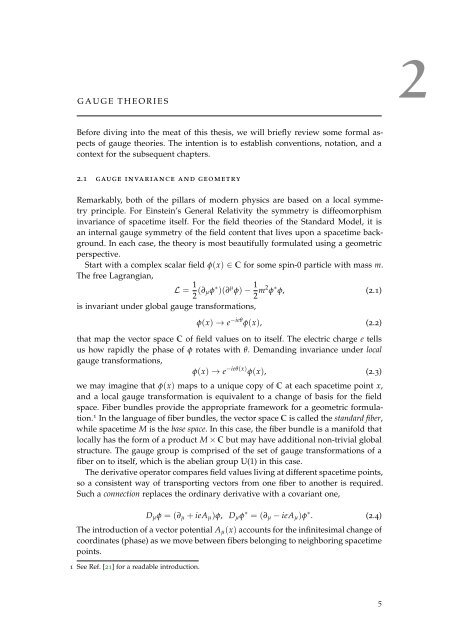Topology, symmetry, and phase transitions in lattice gauge ... - tuprints
Topology, symmetry, and phase transitions in lattice gauge ... - tuprints
Topology, symmetry, and phase transitions in lattice gauge ... - tuprints
Create successful ePaper yourself
Turn your PDF publications into a flip-book with our unique Google optimized e-Paper software.
G A U G E T H E O R I E S<br />
2<br />
Before div<strong>in</strong>g <strong>in</strong>to the meat of this thesis, we will briefly review some formal aspects<br />
of <strong>gauge</strong> theories. The <strong>in</strong>tention is to establish conventions, notation, <strong>and</strong> a<br />
context for the subsequent chapters.<br />
2.1 <strong>gauge</strong> <strong>in</strong>variance <strong>and</strong> geometry<br />
Remarkably, both of the pillars of modern physics are based on a local <strong>symmetry</strong><br />
pr<strong>in</strong>ciple. For E<strong>in</strong>ste<strong>in</strong>’s General Relativity the <strong>symmetry</strong> is diffeomorphism<br />
<strong>in</strong>variance of spacetime itself. For the field theories of the St<strong>and</strong>ard Model, it is<br />
an <strong>in</strong>ternal <strong>gauge</strong> <strong>symmetry</strong> of the field content that lives upon a spacetime background.<br />
In each case, the theory is most beautifully formulated us<strong>in</strong>g a geometric<br />
perspective.<br />
Start with a complex scalar field φ(x) ∈ C for some sp<strong>in</strong>-0 particle with mass m.<br />
The free Lagrangian,<br />
is <strong>in</strong>variant under global <strong>gauge</strong> transformations,<br />
L = 1 2 (∂ µφ ∗ )(∂ µ φ) − 1 2 m2 φ ∗ φ, (2.1)<br />
φ(x) → e −ieθ φ(x), (2.2)<br />
that map the vector space C of field values on to itself. The electric charge e tells<br />
us how rapidly the <strong>phase</strong> of φ rotates with θ. Dem<strong>and</strong><strong>in</strong>g <strong>in</strong>variance under local<br />
<strong>gauge</strong> transformations,<br />
φ(x) → e −ieθ(x) φ(x), (2.3)<br />
we may imag<strong>in</strong>e that φ(x) maps to a unique copy of C at each spacetime po<strong>in</strong>t x,<br />
<strong>and</strong> a local <strong>gauge</strong> transformation is equivalent to a change of basis for the field<br />
space. Fiber bundles provide the appropriate framework for a geometric formulation.<br />
1 In the language of fiber bundles, the vector space C is called the st<strong>and</strong>ard fiber,<br />
while spacetime M is the base space. In this case, the fiber bundle is a manifold that<br />
locally has the form of a product M × C but may have additional non-trivial global<br />
structure. The <strong>gauge</strong> group is comprised of the set of <strong>gauge</strong> transformations of a<br />
fiber on to itself, which is the abelian group U(1) <strong>in</strong> this case.<br />
The derivative operator compares field values liv<strong>in</strong>g at different spacetime po<strong>in</strong>ts,<br />
so a consistent way of transport<strong>in</strong>g vectors from one fiber to another is required.<br />
Such a connection replaces the ord<strong>in</strong>ary derivative with a covariant one,<br />
D µ φ = (∂ µ + ieA µ )φ, D µ φ ∗ = (∂ µ − ieA µ )φ ∗ . (2.4)<br />
The <strong>in</strong>troduction of a vector potential A µ (x) accounts for the <strong>in</strong>f<strong>in</strong>itesimal change of<br />
coord<strong>in</strong>ates (<strong>phase</strong>) as we move between fibers belong<strong>in</strong>g to neighbor<strong>in</strong>g spacetime<br />
po<strong>in</strong>ts.<br />
1 See Ref. [21] for a readable <strong>in</strong>troduction.<br />
5
















